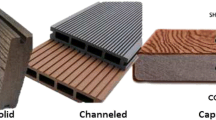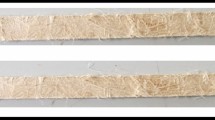Abstract
The reinforcement and compatibilization efficiency of shield powder (modified steel slag powder) for partial replacement of active calcium carbonate filler in styrene–butadiene rubber (SBR) composites was investigated in this work. It was found that the addition of shield powder could shorten the curing time, promote vulcanization process, improve mechanical properties and flame retardant properties of SBR composites. Besides, the optimal comprehensive performance was obtained when the shield powder replaced 60% active calcium carbonate, in which the torque increment (ΔM) was 4.94, being increased by 36.84%, the tensile strength was 11.96 MPa, being increased by 20.81%, the proportion of a stable weight residue at 700 °C was 17.02%, being increased by 13.27%. These phenomena show that shield powder plays a good reinforcing and compatibilizing effect in the SBR system. This is because the shield powder has a finer particle size and a large specific surface area, so that it can produce more crosslinking points with the rubber matrix, and the crosslinking density value with the rubber matrix becomes larger, while the modification of the silane coupling agent improves the compatibility of the shield powder/rubber and enhances the interaction between them. In addition, shield powder can form an effective physical barrier to hinder the transfer of oxygen and heat, while filling the small holes generated by combustion, adsorbed on the surface of carbon slag, promote the formation of secondary carbon layer, and improve the flame retardant performance of SBR composites.






Similar content being viewed by others
References
Fan Y, Fowler GD, Zhao M (2020) The past, present and future of carbon black as a rubber reinforcing filler—a review. J Clean Prod 247:119115
Roy K, Pongwisuthiruchte A, Debnath SC et al (2021) Application of cellulose as green filler for the development of sustainable rubber technology. Curr Res Green Sustain Chem 4:100140
Surya I, Ismail H (2019) The degree of filler dispersion, rheometric and mechanical properties of carbon black-filled styrene-butadiene rubber composites in the presence of alkanolamide. Conf Ser Mater Sci Eng 523(1):012063
Mondal D, Ghorai S, Rana D et al (2019) The rubber–filler interaction and reinforcement in styrene butadiene rubber/devulcanize natural rubber composites with silica–graphene oxide. Polym Compos 40(S2):E1559–E1572
He Z, Li Y, Liu C et al (2022) Turning lignin into treasure: an innovative filler comparable to commercial carbon black for the green development of the rubber industry. Int J Biol Macromol 218:891–899
Xiao Y, Hao Y, Yan L et al (2022) Mechanism on surface hydrophobically modification of fibrous wollastonite and its reinforcement of natural rubber. J Polym Res 29(8):1–14
Xie X, Yang D (2022) Multi-functionalization of Al2O3 nanoparticles for enhancing thermal conductivity of epoxy natural rubber composites. Appl Surf Sci 602:154335
Greenough S, Dumont MJ, Prasher S (2021) The physicochemical properties of biochar and its applicability as a filler in rubber composites: a review. Mater Today Commun 29:102912
Ren X, Sancaktar E (2019) Use of fly ash as eco-friendly filler in synthetic rubber for tire applications. J Clean Prod 206:374–382
de Paiva FFG, de Maria VPK, Torres GB et al (2019) Sugarcane bagasse fiber as semi-reinforcement filler in natural rubber composite sandals. J Mater Cycles Waste Manag 21(2):326–335
Sheikh SH, Yin X, Ansarifar A et al (2017) The potential of kaolin as a reinforcing filler for rubber composites with new sulfur cure systems. J Reinf Plast Compos 36(16):1132–1145
Guo J, Bao Y, Wang M (2018) Steel slag in China: Treatment, recycling, and management. Waste Manag 78:318–330
Li Q, Li B, Li X et al (2022) Microstructure of pretreated steel slag and its influence on mechanical properties of cement stabilized mixture. Constr Build Mater 317:125799
Xu J, Wang K, Wang Y et al (2020) Effects of ferrosilicon alloy, Si content of steel, and slag basicity on compositions of inclusions during ladle furnace refining of Al-killed steel. J Iron Steel Res Int 27(9):1011–1017
Kim H, Lee S (2021) Printability and physical properties of iron slag powder composites using material extrusion-based 3D printing. J Iron Steel Res Int 28(1):111–121
Nazir MT, Phung BT, Hoffman M (2016) Performance of silicone rubber composites with SiO2 micro/nano-filler under AC corona discharge. IEEE Trans Dielectr Electr Insul 23(5):2804–2815
Pei J, Wu J, Huo W et al (2021) Structure characterization and grinding performance of gas-quenched steel slag abrasive. J Iron Steel Res Int 28(4):383–390
Barrera CS, Cornish K (2017) Processing and mechanical properties of natural rubber/waste-derived nano filler composites compared to macro and micro filler composites. Ind Crops Prod 107:217–231
Gobetti A, Cornacchia G, Ramorino G (2021) Innovative reuse of electric arc furnace slag as filler for different polymer matrixes. Minerals 11(8):832
Mohamad Aini NA, Othman N, Hussin MH et al (2019) Hydroxymethylation-modified lignin and its effectiveness as a filler in rubber composites. Processes 7(5):315
Charoenchai M, Tangbunsuk S, Keawwattana W (2020) Silica-graphene oxide nanohybrids as reinforcing filler for natural rubber. J Polym Res 27(8):1–16
Roy K, Debnath SC, Potiyaraj P (2020) A critical review on the utilization of various reinforcement modifiers in filled rubber composites. J Elastomers Plast 52(2):167–193
Das S, Chattopadhyay S, Dhanania S et al (2020) Improved dispersion and physico-mechanical properties of rubber/silica composites through new silane grafting. Polym Eng Sci 60(12):3115–3134
Zhang H, Li H, Long H et al (2021) Spectroscopic analysis of reinforcing-flame retardant mechanism of modified steel slag -mineral powder composite rubber filler. Spectrosc Spectral Anal 41(04):1138–1143
Zhang H, Li Z (2019) microRNA-16 via Twist1 inhibits EMT induced by PM2.5 exposure in human hepatocellular carcinoma. Open Med 14:673–682
Roy K, Debnath SC, Bansod ND et al (2020) Possible use of gypsum waste from ceramics industry as semi-reinforcing filler in epoxidized natural rubber composites. J Mater Cycles Waste Manag 22:285–294
Garing CL, Pajarito B (2018) Experimental and modeling study on the curing properties of natural rubber composites filled with varying proportions of carbon black, modified bentonite and raw bentonite. In: Materials science forum, vol 934. Trans Tech Publications Ltd, pp 50–54
Peng Y, Niu M, Qin R et al (2020) Study on flame retardancy and smoke suppression of PET by the synergy between Fe2O3 and new phosphorus-containing silicone flame retardant. High Perform Polym 32(8):871–882
Qu L, Sui Y, Zhang C et al (2020) Improved flame retardancy of epoxy resin composites modified with a low additive content of silica-microencapsulated phosphazene flame retardant. React Funct Polym 148:104485
Qiao H, Lin X, Zhong W et al (2022) Smoke suppression and thermal conductivity of epoxy resin modified by Al2O3 and hyperbranched flame retardant. J Appl Polym Sci 139(7):51654
Liu X, Zhou X, Yang C et al (2020) Study on the effect of particle size and dispersion of SiO2 on tribological properties of nitrile rubber. Wear 460:203428
Jiang C, Shen H, Bi X et al (2022) A green dual-phase carbon-silica nanohybrid derived from black liquor lignin for reinforcing styrene-butadiene rubber. Compos Sci Technol 230:109775
Senthilvel K, Vishvanathperumal S, Prabu B et al (2016) Studies on the morphology, cure characteristics and mechanical properties of acrylonitrile butadiene rubber with hybrid filler (carbon black/silica) composite. Polym Polym Compos 24(7):473–480
Mohamad Aini NA, Othman N, Hussin MH et al (2020) Lignin as alternative reinforcing filler in the rubber industry: a review. Front Mater 6:329
Sahakaro K (2017) Mechanism of reinforcement using nanofillers in rubber nanocomposites. Progress in rubber nanocomposites. Woodhead Publishing, Cambridge, pp 81–113
Wang N, Xu G, Wu Y et al (2016) The influence of expandable graphite on double-layered microcapsules in intumescent flame-retardant natural rubber composites. J Therm Anal Calorim 123(2):1239–1251
Yotkuna K, Chollakup R, Imboon T et al (2021) Effect of flame retardant on the physical and mechanical properties of natural rubber and sugarcane bagasse composites. J Polym Res 28(12):1–13
Li YT, Liu WJ, Shen FX et al (2022) Processing, thermal conductivity and flame retardant properties of silicone rubber filled with different geometries of thermally conductive fillers: a comparative study. Compos B Eng 238:109907
Zirnstein B, Schulze D, Schartel B (2019) The impact of polyaniline in phosphorus flame retardant ethylene-propylene-diene-rubber (EPDM). Thermochim Acta 673:92–104
Tang D, Zhang X, Hu S et al (2020) The reuse of red brick powder as a filler in styrene-butadiene rubber. J Clean Prod 261:120966
Zhang C, Wang J, Song S (2019) Preparation of a novel type of flame retardant diatomite and its application in silicone rubber composites. Adv Powder Technol 30(8):1567–1575
Acknowledgements
This work was supported by the University Synergy Innovation Program of Anhui Province (GXXT-2020-072).
Author information
Authors and Affiliations
Corresponding author
Ethics declarations
Conflict of interest
The authors declare no conflict of interest.
Additional information
Publisher's Note
Springer Nature remains neutral with regard to jurisdictional claims in published maps and institutional affiliations.
Supplementary Information
Below is the link to the electronic supplementary material.
Rights and permissions
Springer Nature or its licensor (e.g. a society or other partner) holds exclusive rights to this article under a publishing agreement with the author(s) or other rightsholder(s); author self-archiving of the accepted manuscript version of this article is solely governed by the terms of such publishing agreement and applicable law.
About this article
Cite this article
Zheng, Wc., Zhao, L., Xu, Wc. et al. Utilization of shield powder as a novel reinforcing and compatibilizing filler in styrene–butadiene rubber (SBR) composites. J Mater Cycles Waste Manag 25, 2113–2122 (2023). https://doi.org/10.1007/s10163-023-01666-z
Received:
Accepted:
Published:
Issue Date:
DOI: https://doi.org/10.1007/s10163-023-01666-z




